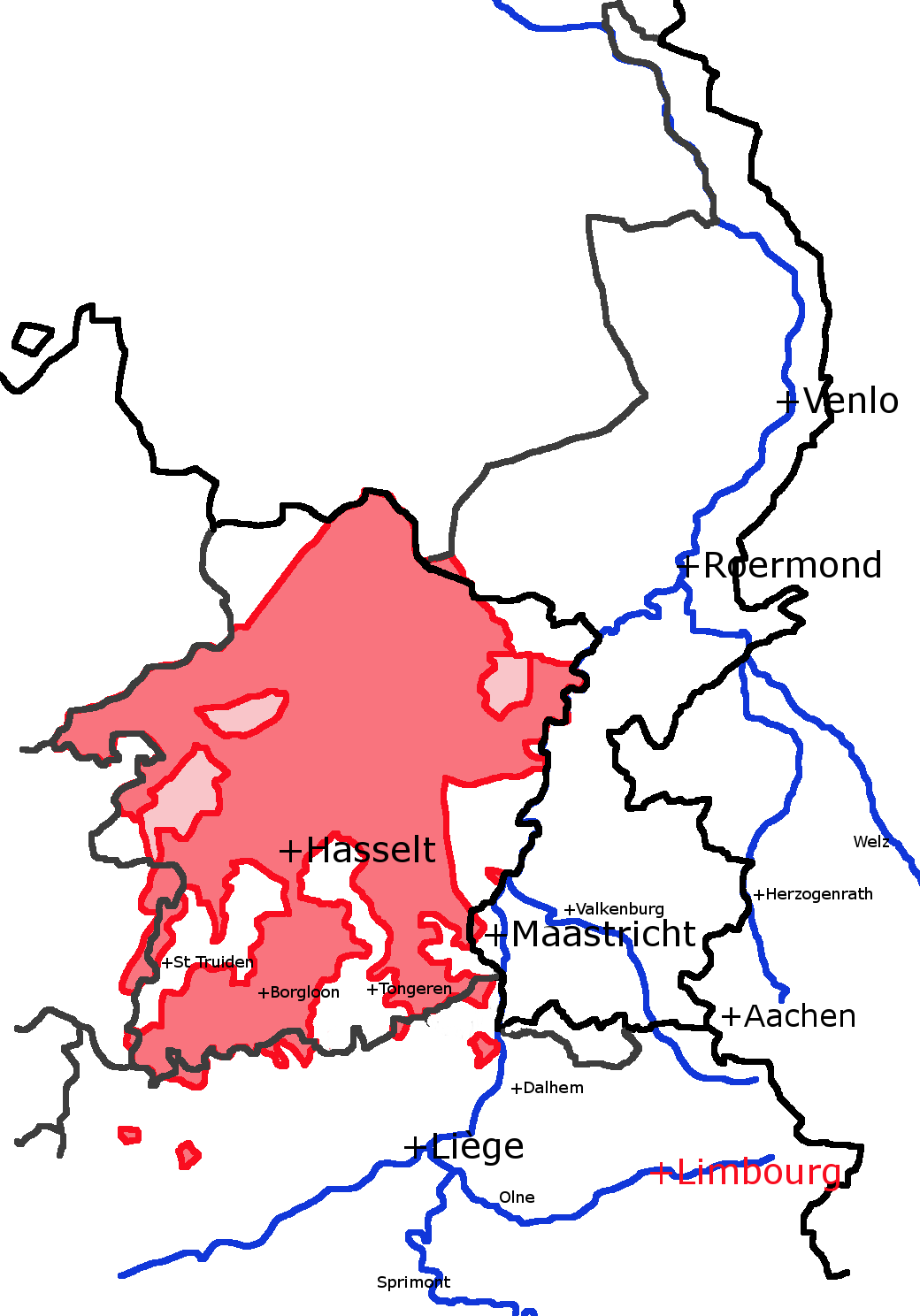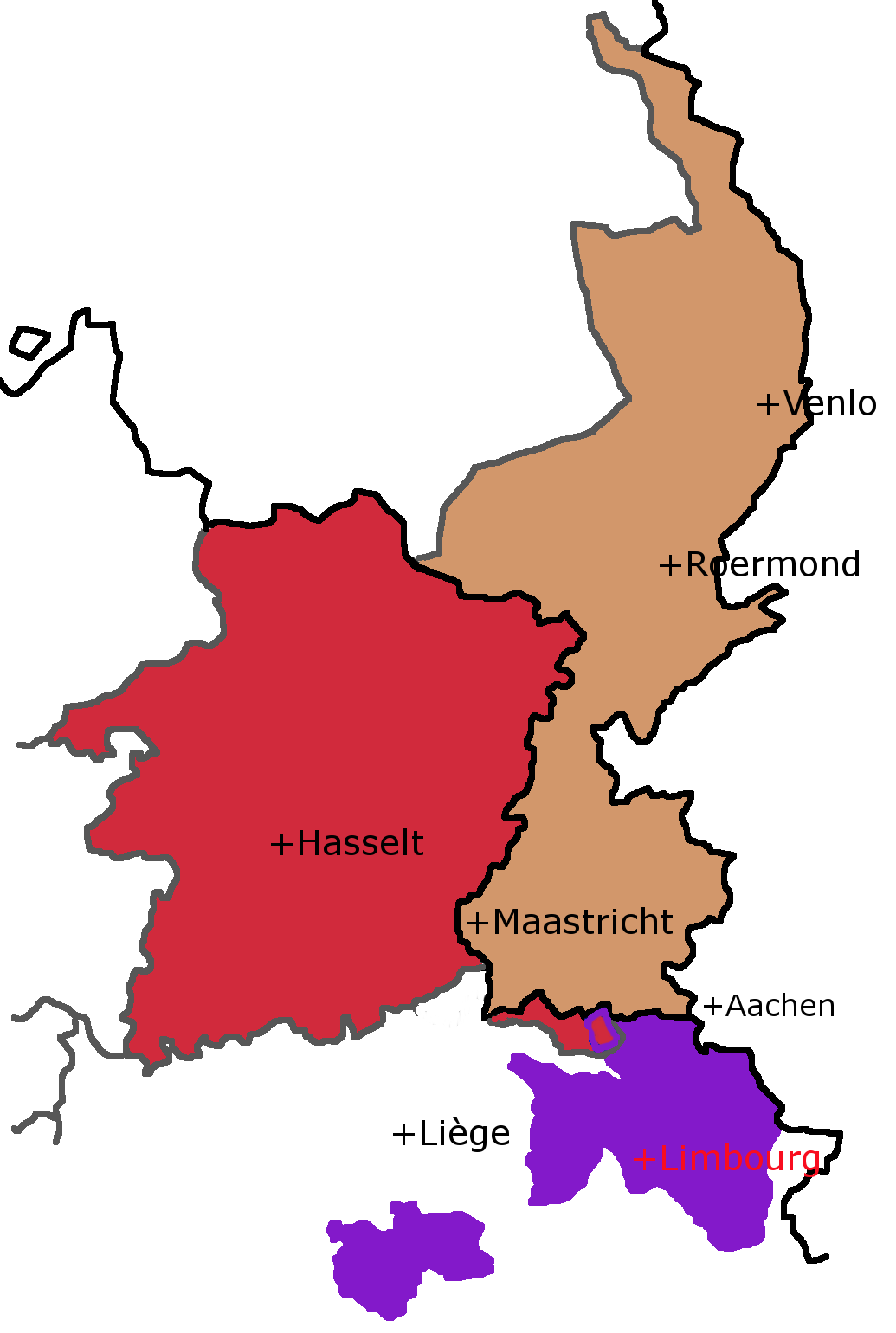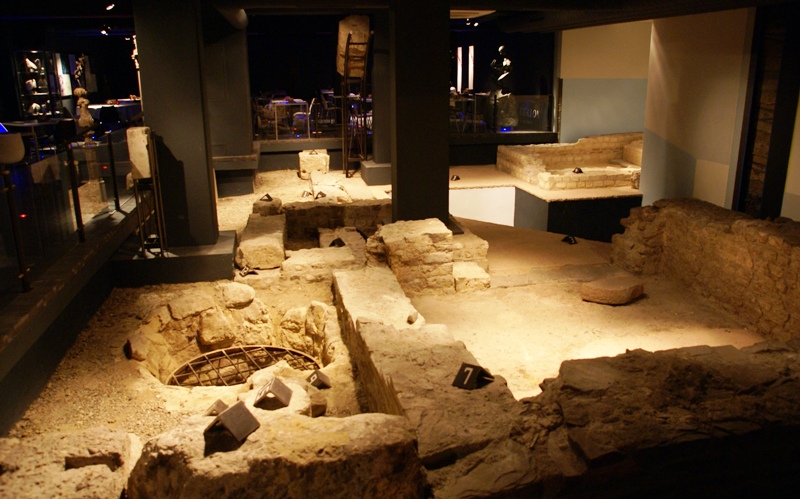|
Meuse-Inférieure
Meuse-Inférieure (; ; ; "Lower Meuse") was a department of the French First Republic and French First Empire in present-day Belgium, Netherlands and Germany. It was named after the river Meuse. Its territory corresponded largely with the present-day provinces of Belgian and Dutch Limburg. It was created on 1 October 1795, when the Austrian Netherlands and the Prince-Bishopric of Liège were officially annexed by the French Republic. Before this annexation, its territory was part of the County of Loon, the Austrian Upper Guelders, the Staats-Oppergelre, the County of Horne, the Abbacy of Thorn, Maastricht and part of the Lands of Overmaas. The original medieval Duchy of Limburg were associated with the Lands of Overmaas, lying to their south. The two regions had long been governed together and referred to collectively with both names, but the original Duchy lands were not part of this new entity. The Chef-lieu of the department was Maastricht. The department was subdivide ... [...More Info...] [...Related Items...] OR: [Wikipedia] [Google] [Baidu] |
County Of Horne
Horne (also ''Horn'', ''Hoorn'' or ''Hoorne'') is a small historic county of the Holy Roman Empire in the present day Netherlands and Belgium. It takes its name from the village Horn, west of Roermond. The residence of the counts of Horne was moved from Horn to Weert in the 15th century. After the execution in 1568 of Philip de Montmorency who died without male heirs, the Prince-Bishop of Liège, as suzerain of Horne, was declared the direct lord and new count. The bishops ruled the county in personal union. Horne maintained its own laws and customs as well as its financial autonomy. The county included the communes of Neer, Nunhem, Haelen, Buggenum, Roggel, Heythuysen, Horne, Beegden, Geystingen and Ophoven.Bulletin de la Commission centrale de statistique, Brussels, 1857, vol. 7, p. 136. It was suppressed in 1795, when it was occupied by the French, and it became part of the French département Meuse-Inférieure. Rulers of Horne Lords of Horne * Engelbert de Hurne, * En ... [...More Info...] [...Related Items...] OR: [Wikipedia] [Google] [Baidu] |
County Of Loon
The County of Loon ( , ) was a county in the Holy Roman Empire, which corresponded approximately with the modern Belgian province of Limburg. It was named after the original seat of its count, Loon, which is today called Borgloon. During the middle ages the counts moved their court to a more central position in Kuringen, which today forms part of Hasselt, capital of the province. From its beginnings, Loon was associated with the nearby Prince-bishop of Liège, and by 1190 the count had come under the bishop's overlordship. In the fourteenth century the male line ended for a second time, at which point the prince-bishops themselves took over the county directly. Loon approximately represented the Dutch-speaking (archaic ) part of the princedom. All of the Dutch-speaking towns in the Prince-Bishopric, with the status of being so-called " Good Cities" (), were in Loon, and are in Belgian Limburg today. These were Beringen, Bilzen, Borgloon, Bree, Hamont, Hasselt, Herk-de-Stad ... [...More Info...] [...Related Items...] OR: [Wikipedia] [Google] [Baidu] |
Limburg (Netherlands)
Limburg (; ), also known as Dutch Limburg, is the southernmost of the twelve provinces of the Netherlands. It is bordered by Gelderland to the north and by North Brabant to the west. Its long eastern boundary forms the border with the German state of North Rhine-Westphalia. To the west is the border with the Belgian province of Limburg, part of which is delineated by the river Meuse. To the south, Limburg is bordered by the Belgian province of Liège. The Vaalserberg is the extreme southeastern point, the tripoint of the Netherlands, Germany, and Belgium. Limburg had a population of about 1,128,000 in January 2023. Its main municipalities are the provincial capital Maastricht (population 120,837 as of January 2022), Venlo (population 102,176) in the northeast, as well as Sittard-Geleen (population 91,760, bordering both Belgium and Germany) and Heerlen (population 86,874) in the south. More than half of the population, approximately 650,000 people, live in the south of Limb ... [...More Info...] [...Related Items...] OR: [Wikipedia] [Google] [Baidu] |
Limburg (Belgium)
Limburg (, ; or ; , ), also known as Belgian Limburg, is a province in Belgium. It is the easternmost of the five Dutch language, Dutch-speaking provinces that together form the Flemish Region, Region of Flanders, which is one of the three main Communities, regions and language areas of Belgium, political and cultural sub-divisions of modern-day Belgium. As of January 2024, Limburg had a population of 0.9 million. Limburg is located west of the Meuse (), which separates it from the similarly-named Netherlands, Dutch province of Limburg (Netherlands), Limburg. To the south it shares a border with the French-speaking province of Liège Province, Liège, with which it also has historical ties. To the north and west are the old territories of the Duchy of Brabant. Today these are the Flemish provinces of Flemish Brabant and Antwerp (province), Antwerp to the west, and the Dutch province of North Brabant to the north. Historically Belgian Limburg is roughly equivalent to the Dutch-s ... [...More Info...] [...Related Items...] OR: [Wikipedia] [Google] [Baidu] |
Departments Of France
In the administrative divisions of France, the department (, ) is one of the three levels of government under the national level ("territorial collectivity, territorial collectivities"), between the Regions of France, administrative regions and the Communes of France, communes. There are a total of 101 departments, consisting of ninety-six departments in metropolitan France, and five Overseas department and region, overseas departments, which are also classified as overseas regions. Departments are further subdivided into 333 Arrondissements of France, arrondissements and 2,054 Cantons of France, cantons (as of 2023). These last two levels of government have no political autonomy, instead serving as the administrative basis for the local organisation of police, fire departments, and, in certain cases, elections. Each department is administered by an elected body called a departmental council (France), departmental council ( , ). From 1800 to April 2015, these were called gene ... [...More Info...] [...Related Items...] OR: [Wikipedia] [Google] [Baidu] |
Thorn, Netherlands
Thorn (; or ''Thoear'') is a city in the municipality of Maasgouw, in the Dutch province of Limburg. It lies on the rivers Meuse and Witbeek. It is known as 'the white city' for its white-washed brick houses in the centre of town. It used to be part of the Imperial Abbey of Thorn. History First, the region of Thorn was a swamp nearby the Roman road between Maastricht and Nijmegen. But the region had been drained and about 975, Bishop Ansfried of Utrecht founded a Benedictine nunnery. This monastery developed since the 12th century into a secular ''stift'' or convent. The principal of the ''stift'' was the abbess. She was assisted by a chapter of at most twenty ladies of the highest nobility. Previously the abbess and the chapter were endowed with religious tasks but, since the 12th century, they served secular matters and formed the government of a truly sovereign miniature principality, a smaller independent state in the German Holy Roman Empire, approximately 250 x 250 metr ... [...More Info...] [...Related Items...] OR: [Wikipedia] [Google] [Baidu] |
Departments Of France
In the administrative divisions of France, the department (, ) is one of the three levels of government under the national level ("territorial collectivity, territorial collectivities"), between the Regions of France, administrative regions and the Communes of France, communes. There are a total of 101 departments, consisting of ninety-six departments in metropolitan France, and five Overseas department and region, overseas departments, which are also classified as overseas regions. Departments are further subdivided into 333 Arrondissements of France, arrondissements and 2,054 Cantons of France, cantons (as of 2023). These last two levels of government have no political autonomy, instead serving as the administrative basis for the local organisation of police, fire departments, and, in certain cases, elections. Each department is administered by an elected body called a departmental council (France), departmental council ( , ). From 1800 to April 2015, these were called gene ... [...More Info...] [...Related Items...] OR: [Wikipedia] [Google] [Baidu] |
Overmaas
The Lands of Overmaas (; ) were a collection of lordships near Limburg in the Low Countries which were attached to the Duchy of Brabant and existed from the 13th to 18th centuries. Acquired by the Valois Dukes of Burgundy along with Brabant in the 15th century, they later passed to the House of Habsburg and were partitioned between the Habsburg Spanish Netherlands and the Dutch Republic in 1648. The Lands of Overmaas ceased to exist as lordships with the abolition of feudalism in 1795, following the annexation of the area by Revolutionary France. Etymology The territories' rulers, the Dukes of Brabant, called their possessions in the area ''De Landen van Overmaas'', meaning "the countries over the Meuse". This was because, from their perspective from their residence in Brussels, the area was on the "other side" (that is, the right bank) of the river Meuse (). History The Lands of Overmaas were a collection of small medieval lordships in the vicinity of Limburg, and located bet ... [...More Info...] [...Related Items...] OR: [Wikipedia] [Google] [Baidu] |
Prince-Bishopric Of Liège
The Prince-Bishopric of Liège or Principality of Liège was a Roman Catholic ecclesiastical principality of the Holy Roman Empire that was situated for the most part in present-day Belgium. It was an Imperial Estate, so the bishop of Liège, as its prince, had a seat and a vote in the Imperial Diet. The Prince-Bishopric of Liège should not be confused with the Diocese of Liège, which was larger and over which the prince-bishop exercised only the usual responsibilities of a bishop. The bishops of Liège acquired their status as prince-bishops between 980 and 985 when Bishop Notker of Liège, who had been the bishop since 972, received secular control of the County of Huy from Emperor Otto II. From 1500, the prince-bishopric belonged to the Lower Rhenish–Westphalian Circle. Its territory included most of the present Belgian provinces of Liège and Limburg, and some exclaves in other parts of Belgium and the Netherlands. The ecclesiastical state briefly became a republic ... [...More Info...] [...Related Items...] OR: [Wikipedia] [Google] [Baidu] |
Duchy Of Limburg
The Duchy of Limburg or Limbourg was an imperial estate of the Holy Roman Empire. Much of the area of the duchy is today located within Liège Province of Belgium, with a small portion in the municipality of Voeren, an Enclave and exclave, exclave of the neighbouring Limburg (Belgium), Limburg Province. Its chief town was Limbourg, Limbourg-sur-Vesdre, in today's Liège Province. The duchy evolved from a county which was first assembled under the lordship of a junior member of the House of Ardenne–Luxembourg, Frederick, Duke of Lower Lorraine, Frederick. He and his successors built and apparently named the fortified town which the county, and later the duchy, were named after. Despite being a younger son, Frederick had a successful career and also became duke of Lower Lotharingia in 1046. Lordship of this county was not originally automatically linked with possession of a ducal title (''Herzog'' in German, ''Hertog'' in Dutch), and the same title was also eventually contested b ... [...More Info...] [...Related Items...] OR: [Wikipedia] [Google] [Baidu] |
Maastricht
Maastricht ( , , ; ; ; ) is a city and a Municipalities of the Netherlands, municipality in the southeastern Netherlands. It is the capital city, capital and largest city of the province of Limburg (Netherlands), Limburg. Maastricht is located on both sides of the Meuse (), at the point where the river is joined by the Jeker. Mount Saint Peter (''Sint-Pietersberg'') is largely situated within the city's municipal borders. Maastricht is adjacent to the border with Belgium and is part of the Meuse-Rhine Euroregion, an international metropolis with a population of about 3.9 million, which includes the nearby German and Belgian cities of Aachen, Liège, and Hasselt. Maastricht developed from a Roman Republic, Roman settlement (''Trajectum ad Mosam'') to a medieval river trade and religious centre. In the 16th century it became a garrison town and in the 19th century an early industrial centre. Today, the city is a thriving cultural and regional hub. It became well known through ... [...More Info...] [...Related Items...] OR: [Wikipedia] [Google] [Baidu] |
Departments Of French Empire MeuseInf 1811
Department may refer to: * Departmentalization, division of a larger organization into parts with specific responsibility Government and military *Department (administrative division), a geographical and administrative division within a country, for example: **Departments of Colombia, a grouping of municipalities **Departments of France, administrative divisions three levels below the national government **Departments of Honduras **Departments of Peru, name given to the subdivisions of Peru until 2002 **Departments of Uruguay *Department (United States Army), corps areas of the U.S. Army prior to World War I *Fire department, a public or private organization that provides emergency firefighting and rescue services *Ministry (government department), a specialized division of a government *Police department, a body empowered by the state to enforce the law * Department (naval) administrative/functional sub-unit of a ship's company. Other uses * ''Department'' (film), a 2012 Bollywoo ... [...More Info...] [...Related Items...] OR: [Wikipedia] [Google] [Baidu] |






